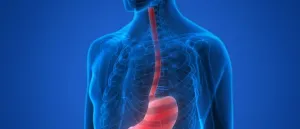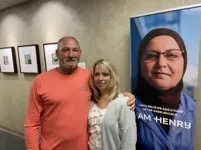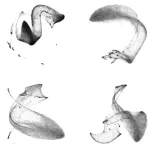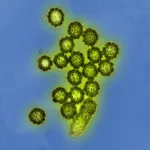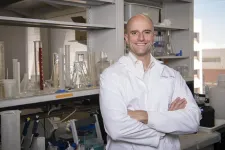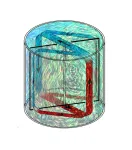(Press-News.org) CLEVELAND—Irregularities in the body’s genetic coding to make proteins are linked to cancerous tumors. But most genetic material contains elements whose function isn’t clear.
Could abnormalities in non-coding material also impact a person’s health, or even be linked to cancers as well?
A new study by researchers at the Case Western Reserve University School of Medicine suggests that the non-coding genetic molecules also play a key role in health and disease, including tumor development.
More specifically, they’ve discovered that these molecules may hold promise for warning of malignancies such as esophageal cancer, where a lack of biomarkers makes it hard to detect and treat tumors early.
“What we wanted to find out,” said Kishore Guda, an associate professor at the School of Medicine and lead researcher of the study recently published in the peer-reviewed journal Gastroenterology, “was can we use these as potential biomarkers for developing cancers?”
Ribonucleic acid (RNA) codes for proteins and carries genetic information in all living cells. In cancers, these RNA molecules are not only “turned on,” but also appear to be activated in cells that are likely to progress to cancer.
With that knowledge, it may be possible to detect cancers at an early stage—or even before they become cancer—making it possible to improve patient outcomes and even survival.
In their study, the researchers performed the first discovery and characterization of a specialized sub-class of what is known as “long intergenic” non-coding RNA molecules in esophageal malignancy.
What they found: A panel of these molecules was also “turned on” in cancer tissues and in pre-malignant tissues (for example, those at a high risk for becoming cancer). And these RNA molecules can be detected in patient biopsy tissues using routine imaging.
Those RNA molecules also seem to inhibit the growth of esophageal cancer cells by regulating other genes potentially involved in cancer development, thus providing new opportunities for therapeutic targeting of these cancers, the authors concluded.
“Our study opens a new area of investigation by implicating these RNA molecules as additional players in esophageal cancer,” Guda said. “Our goal is to understand how and when these molecules are turned-on during esophageal cancer development, and how they control other genes involved in cancer processes.”
With this new knowledge, the team hopes to test whether the RNA molecules can be integrated into CWRU's EsoCheck molecular diagnostic panel—licensed to Lucid Diagnostics—for detecting cells at a high risk of becoming cancerous.
They also want to test whether blocking the RNA molecules, or blocking the genes controlled by these molecules, might lead to a new treatment strategy for a cancer that is often lethal.
###
Case Western Reserve University is one of the country's leading private research institutions. Located in Cleveland, we offer a unique combination of forward-thinking educational opportunities in an inspiring cultural setting. Our leading-edge faculty engage in teaching and research in a collaborative, hands-on environment. Our nationally recognized programs include arts and sciences, dental medicine, engineering, law, management, medicine, nursing and social work. About 6,000 undergraduate and 6,300 graduate students comprise our student body. Visit case.edu to see how Case Western Reserve thinks beyond the possible.
END
Newly discovered RNA molecules hold promise for detecting and treating esophageal cancer
2023-05-15
ELSE PRESS RELEASES FROM THIS DATE:
Henry Ford Health cardiologists look to the past to create new heart bypass procedure
2023-05-15
DETROIT (May 15, 2023) – Henry Ford Health Interventional cardiologists William O’Neill, M.D., and Khaldoon Alaswad, M.D., took a page out of the medical history books by performing a new coronary bypass procedure replicated from one not used in decades to treat a patient living with crippling angina ― a severe symptom of coronary artery disease.
Retired painting contractor Fred Casciano, 60, from Traverse City, became the first patient anywhere to receive the life-changing transcatheter procedure on April 12 at Henry Ford Hospital in Detroit. The procedure was re-engineered from an operation first developed in the 1950s.
“This new ...
Novel AI-based software enables quick and reliable imaging of proteins in cells
2023-05-15
The more, the better
“TomoTwin paves the way for automated identification and localization of proteins directly in their cellular environment, expanding the potential of cryo-ET,” says Gavin Rice, co-first author of the publication. Cryo-ET has the potential to decipher how biomolecules work within a cell and, by that, to unveil the basis of life and the origin of diseases.
In a cryo-ET experiment, scientists use a transmission electron microscope to obtain 3D images, called tomograms, of the cellular volume containing complex biomolecules. To gain a more detailed image of ...
Clinical trial of mRNA universal influenza vaccine candidate begins
2023-05-15
A clinical trial of an experimental universal influenza vaccine developed by researchers at the National Institute of Allergy and Infectious Diseases’ (NIAID) Vaccine Research Center (VRC), part of the National Institutes of Health, has begun enrolling volunteers at Duke University in Durham, North Carolina. This Phase 1 trial will test the experimental vaccine, known as H1ssF-3928 mRNA-LNP, for safety and its ability to induce an immune response.
The trial will enroll up to 50 healthy volunteers aged ...
UArizona Health Sciences researchers unlocking new answers in the quest for safer, more effective opioid therapy
2023-05-15
TUCSON, Arizona — University of Arizona Health Sciences researchers are taking the foot off the brake in their quest to improve opioid therapy while decreasing its side effects.
Led by John Streicher, PhD, a Department of Pharmacology associate professor in the UArizona College of Medicine – Tucson and a member of the UArizona Health Sciences Comprehensive Pain and Addiction Center, the researchers have expanded upon their previous research focused on one specific protein – heat shock protein 90 – and its role in opioid receptor activation and pain relief. Their prior investigations have ...
Dr. Laura Moyer elected as Fellow of ASM International
2023-05-15
Dr. Laura Moyer ’99 ’02G ’05 PhD, manager of metallography, light optical microscopy, and X-ray diffraction at Lehigh University, has been elected as a Fellow of ASM International, the leading association of engineers and scientists in the field of materials science.
The honor recognizes Moyer’s “outstanding leadership and technical contributions to the education of personnel in both manufacturing and academia,” benefitting the field of materials science and engineering. The ...
Researchers design smaller, lighter space-based imaging spectrometers with high spectral resolution
2023-05-15
Researchers have developed a new smaller, lighter design for space-based imaging spectrometers with high spectral resolution. These high-dispersion imaging spectrometers could be used onboard spacecraft or satellites to study the Earth’s atmosphere or the atmospheres of other planets.
James P. McGuire, Jr. from NASA’s Jet Propulsion Laboratory in Southern California will present the new research at the Optica Design and Fabrication Conference, which will take place 04 – 08 June 2023 in Quebec City, Canada.
“This spectrometer provides the same measurement capabilities as conventional designs, but at one tenth the ...
Sleep Research Society announces 2023 award recipients
2023-05-15
DARIEN, IL – Four individuals have been selected as the 2023 Sleep Research Society award recipients for their outstanding contributions to the SRS, sleep and circadian science, and public health. They will be recognized Monday, June 5, during the plenary session of the SLEEP 2023 annual meeting of the Associated Professional Sleep Societies in Indianapolis.
“The SRS awards recognize the highest achievements by sleep and circadian scientists whose work supports our mission to cultivate knowledge in the field and to optimize health and well-being,” said SRS President Namni Goel. “I congratulate these leaders ...
Physicists take the temperature of fluid flows and discover new role for turbulence
2023-05-15
A team of physicists has discovered a new role for a specific type of turbulence—a finding that sheds light on fluid flows ranging from the Earth’s liquid core to boiling water.
The research, which appears in the journal Proceedings of the National Academy of Sciences, centered on turbulent convection—the movement of fluid when heated from below.
“Our experiments reveal intricate movements between a free-moving body and thermal convective flows,” says Jun Zhang, a professor of mathematics and physics at New York University and NYU Shanghai, the paper’s senior author.
The study, which also included Kaizhe Wang, a researcher ...
Tiny proteins found across the animal kingdom play a key role in cancer spread
2023-05-15
Phosphatases of regenerating liver (PRLs) are a family of enigmatic proteins involved in cell growth and metabolism present in various species. From humans to fruit flies, they play a unique role in the growth of cancerous tumours and the spread of cancer throughout the body. New research emerging from McGill University is contributing to what is known about PRLs, which could potentially become an important tool in the development of cancer-fighting treatments.
Led by Kalle Gehring, a professor in the Department of Biochemistry and founding director of the McGill Centre for Structural Biology, the researchers focused on unravelling the mystery around PRLs. “It's ...
Great inequality in international athletics
2023-05-15
Athletes from less affluent countries need more education on health to prevent injuries during hard training. But, paradoxically, more knowledge can also increase the risk of injury if there is no access to medically trained expertise. This is the conclusion of researchers at Linköping University, Sweden, in a new study on inequality in athletics.
“There were astronomical differences in support resources between juniors from different parts of the world. European competitors had entire medical teams and computer-based analysis programs ...
